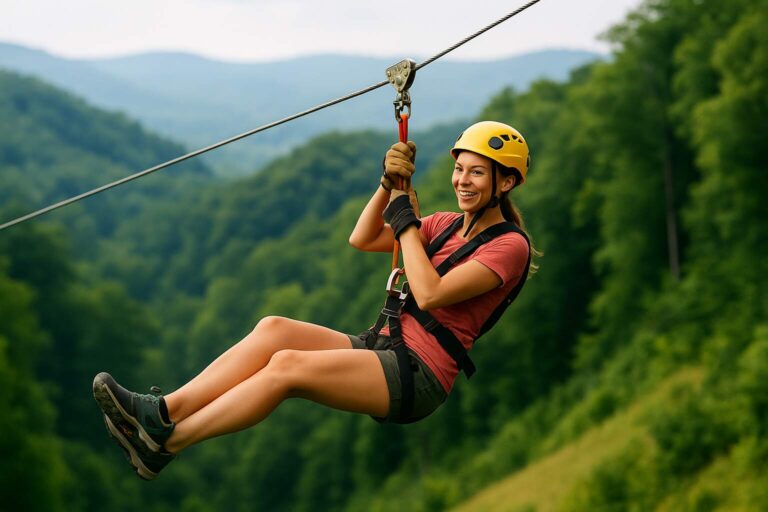Ziplining is an exhilarating outdoor activity that allows you to soar through the treetops, taking in breathtaking views and experiencing an adrenaline rush like no other. However, if you’re planning to embark on a ziplining adventure, you might be wondering, “Do ziplines have weight limits?”
Yes, ziplines typically have weight limits. These weight limits are established for safety reasons, as they ensure that the zipline equipment, including cables and harnesses, can safely support the weight of the participants. The specific weight limit can vary depending on the zipline operator, location, and equipment used but typically participants must weigh within the range of 50 to 250/275 pounds (113 to 125 kilograms).
In this comprehensive guide, we will provide you with a simple and informative explanation of zipline weight limits, including why they exist, how they are determined, and what you can do to ensure a safe and enjoyable experience.
The Basics of Ziplining
Before delving into the specifics of weight limits, let’s start with a brief overview of what ziplining entails. A zipline consists of a cable stretched between two points, typically high above the ground. Participants are harnessed to a pulley system and attached to the cable, allowing them to glide from one end to the other at high speeds. Ziplining is a popular recreational activity found in various locations around the world, often in natural settings like forests, canyons, or mountainous areas.
Why Do Ziplines Have Weight Limits?
Ziplines have weight limits primarily for safety reasons. The main factors that influence weight limits on ziplines include:
1. Cable Strength and Durability
Zipline cables are designed to withstand a specific amount of weight and stress. Exceeding these limits could result in cable failure, leading to catastrophic accidents. To ensure the safety of participants and the longevity of the equipment, zipline operators establish weight restrictions.
2. Speed Control
The weight of the rider also affects the speed at which they travel on the zipline. Heavier riders will descend more quickly than lighter riders. Zipline operators set weight limits to maintain a reasonable and consistent speed for all participants, enhancing the overall experience and safety.
3. Braking System Efficiency
Ziplines are equipped with braking systems to slow down and stop participants at the end of the ride. Heavier riders generate more momentum, and the braking system must be capable of safely stopping them. Weight limits help ensure that the braking systems can effectively control the speed of all participants.
How Are Zipline Weight Limits Determined?
The process of determining weight limits for ziplines is not one-size-fits-all and can vary from one zipline to another. Several factors influence the calculation of weight limits, including:
1. Zipline Design
The design of the zipline, including the type and strength of the cables, the pulley system, and the braking mechanisms, plays a significant role in setting weight limits. Zipline engineers and manufacturers consider these factors when establishing weight restrictions.
2. Location and Terrain
The geographical location and terrain where the zipline is installed can impact weight limits. Ziplines in mountainous regions may have different weight limits compared to those in flatter areas due to variations in cable tension and terrain.
3. Safety Standards and Regulations
Zipline operators are often subject to safety standards and regulations set by local authorities or industry associations. These standards may include specific weight limits to ensure compliance with safety guidelines.
4. Equipment Specifications
The quality and specifications of the ziplining equipment, including harnesses and pulleys, are essential in determining weight limits. High-quality equipment may allow for higher weight capacities.
5. Manufacturer Recommendations
Zipline operators typically follow the manufacturer’s recommendations for weight limits. Manufacturers have extensive knowledge of their equipment’s capabilities and provide guidelines to ensure safe operation.
Typical Zipline Weight Limits
While weight limits can vary depending on the factors mentioned above, it’s helpful to provide a general idea of what you might encounter when planning a ziplining adventure. Keep in mind that these are approximate figures and may not apply universally:
- Minimum Weight: Ziplines often have a minimum weight requirement to ensure that participants have enough mass to reach the end of the line safely. This requirement is typically around 70-90 pounds (32-41 kilograms).
- Maximum Weight: The maximum weight limit for ziplines typically ranges from 250 to 300 pounds (113-136 kilograms). However, this can vary significantly depending on the specific zipline, so it’s essential to check with the operator.
Ziplining Regulations Worldwide
While the concept of ziplining remains consistent across the globe, the regulations and weight limits associated with this thrilling adventure activity can vary significantly from one country or region to another. It’s essential for travelers and adventure enthusiasts to be aware of these differences when planning a ziplining experience abroad. Let’s explore some examples of ziplining regulations in different parts of the world:
1. United States
In the United States, ziplining regulations vary by state, with individual states often setting their own safety standards and guidelines. However, some overarching principles are commonly followed:
- Weight Limits: Weight limits in the U.S. can range from 250 to 300 pounds (113-136 kilograms) for many ziplines, but it’s crucial to check with the specific operator for their guidelines.
- Safety Standards: Ziplines must adhere to industry standards set by organizations like the Association for Challenge Course Technology (ACCT) and follow local regulations.
2. Costa Rica
Costa Rica is known for its stunning rainforests and ziplining experiences. In this country, zipline operators often have weight limits between 250 and 280 pounds (113-127 kilograms). Safety is a top priority, given the pristine natural settings where ziplines are situated.
3. Thailand
Thailand’s ziplining adventures, often set in lush jungle environments, typically have weight limits ranging from 220 to 330 pounds (100-150 kilograms). These limits can vary depending on the specific zipline course and operator.
4. New Zealand
New Zealand is renowned for its adventurous spirit and breathtaking landscapes. Here, zipline weight limits tend to be around 275 to 300 pounds (125-136 kilograms), ensuring safe and enjoyable rides amidst the country’s scenic beauty.
5. South Africa
In South Africa, where ziplining opportunities abound, weight limits generally range from 220 to 330 pounds (100-150 kilograms). Operators in this region emphasize safety and often conduct thorough safety briefings.
6. European Destinations
In various European countries, ziplining is a popular activity in mountainous regions. Weight limits can differ significantly, with many operators allowing participants weighing between 220 and 250 pounds (100-113 kilograms). European countries typically adhere to EU safety standards.
7. Australia
Australia offers ziplining experiences in diverse landscapes. Weight limits for Australian ziplines are usually in the range of 242 to 286 pounds (110-130 kilograms), ensuring the safety of participants.
Here’s a table summarizing ziplining weight limits and regulations in different countries and regions around the world:
Country/Region |
Weight Limits (Approximate) |
Additional Regulations |
|---|---|---|
| United States | 250-300 pounds (113-136 kilograms) | Adherence to ACCT and local standards |
| Costa Rica | 250-280 pounds (113-127 kilograms) | Safety focus in rainforest environments |
| Thailand | 220-330 pounds (100-150 kilograms) | Varies by zipline operator and course |
| New Zealand | 275-300 pounds (125-136 kilograms) | Ensuring safety amidst scenic landscapes |
| South Africa | 220-330 pounds (100-150 kilograms) | Thorough safety briefings common |
| European Destinations | 220-250 pounds (100-113 kilograms) | Compliance with EU safety standards |
| Australia | 242-286 pounds (110-130 kilograms) | Ensuring participant safety |
Important Note: Keep in mind that these weight limits are approximate and can change over time. It’s essential to check with the zipline operator in your chosen destination for their specific weight restrictions. Additionally, safety regulations and standards may evolve, so staying up-to-date on local guidelines is crucial.
Whether you’re planning a ziplining adventure in the United States, Costa Rica, Thailand, New Zealand, South Africa, Europe, or Australia, understanding the weight limits and regulations specific to your chosen destination is essential. Prior research and communication with zipline operators will help you ensure a safe and memorable experience, no matter where in the world you decide to take flight on a zipline.
Tips for a Safe Ziplining Experience
Now that you understand why ziplines have weight limits and how they are determined, here are some tips to ensure a safe and enjoyable ziplining experience:
- Check with the Operator: Before booking your ziplining adventure, contact the zipline operator to inquire about their specific weight limits and requirements. They can provide you with accurate information based on their equipment and location.
- Follow Instructions: Pay close attention to the instructions provided by the zipline guides. They will give you important information on how to use the equipment, maintain a safe body position, and enjoy the ride to the fullest.
- Wear Proper Attire: Dress appropriately for your ziplining adventure. Wear comfortable clothing and closed-toe shoes. Some operators may have dress code requirements for safety reasons.
- Secure All Loose Items: Make sure to secure any loose items, such as hats, sunglasses, or cameras, before starting your zipline journey. These items can become hazards if they fall during the ride.
- Respect Weight Limits: If you’re near the weight limit specified by the operator, it’s essential to respect their guidelines. Exceeding weight limits can compromise safety.
- Enjoy the Scenery: Ziplining offers a unique opportunity to appreciate the beauty of nature from a different perspective. Take in the breathtaking views and savor the moment.
Conclusion
In summary, ziplines do have weight limits, and these limits are crucial for ensuring the safety of participants and the integrity of the equipment. The weight limits are determined by various factors, including the design of the zipline, location, safety standards, and equipment specifications. It’s essential to check with the zipline operator for their specific weight restrictions before planning your adventure.
Ziplining can be an incredible and memorable experience, offering a thrilling combination of adrenaline and natural beauty. By understanding and adhering to weight limits and following safety guidelines, you can enjoy a safe and exhilarating ziplining adventure that you’ll cherish for years to come.








